Longest AND fastest passage!
As I mentioned in our brief check-in yesterday, the conditions during our passage were, for the most part, quite favorable so we won’t complain. That said, I do dream of a place that has favorable wind for sailing without the uncomfortable waves that tend to be generated by it. Does such a place exist? If so, let me know because I’d love to sail there!
Our passage began at 6:00 AM on the 26th, an hour later than we had hoped to get underway. While we were up on time, and had coffee in hand and were ready to go at 5:00 AM, we were faced with a couple of technical problems: both our running lights and our steaming light would not illuminate. As we were planning to leave in the dark, and would be sailing during at least two nights, I was pretty certain that we should have some lights so that other ships could see us on the water. As luck would have it, within an hour I was able to troubleshoot and fix both issues which, as it turned out, were completely unrelated. The steaming light, and all of our masthead lights for that matter, were not working because of a loose ground wire at the mast step while the running lights at the bow wouldn’t work because the bulb had blown out. Fortunately, we had a spare bulb so, with that replaced, and the ground wire at the mast cleaned up and reattached, we were all lit up and ready to go.
Immediately after setting sail, we could see that we were going to enjoy some good speed. We were running with a single reef in the main and full genoa and once clear of Bequia’s shadow, were making 6-7 knots easily. The waves at this time were reasonable as well, and our hopes for a pleasant and fast passage were buoyed.

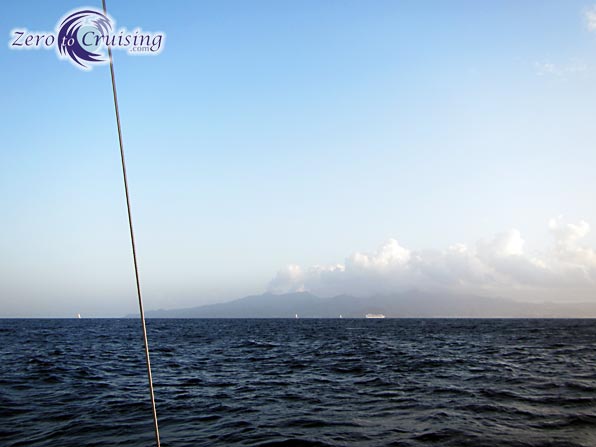


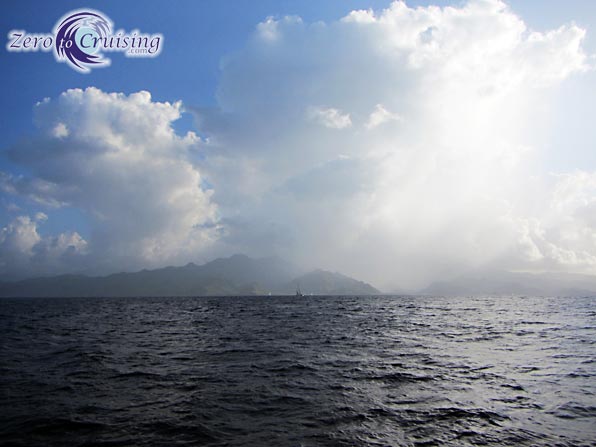
We have heard that in order to obtain clean wind in the lee of an island, that which is unaffected by land, you need to be seven times the height of the landmass away from it. Our experience is that it seems to be even greater than that! While we did appreciate St. Vincent giving us a respite from the waves that had been rolling unimpeded across the Atlantic Ocean, we weren’t quite so happy about it taking away all of our wind. Not willing to see the profits from our good speed squandered, we started an engine to get us through the dead zone. The wind would soon come back but we would go on to see that pattern repeat itself again later in the day as we passed St. Lucia, this time even further offshore, approximately 24 miles. Are the mountains of St. Lucia 3.5 miles high? I don’t think so.
With those two small exceptions, the wind remained near perfect all through the day and the first night. We were sailing on a beam reach for much of the time with speeds in the 7-8 knot range, occasionally jumping up into the 9s. While that may not seem fast to many of our sailing buddies, for us, it is fast! The first night passed uneventfully, well lit by the nearly full moon. While we did see plenty of shipping traffic, none came closer than 3-4 miles away.


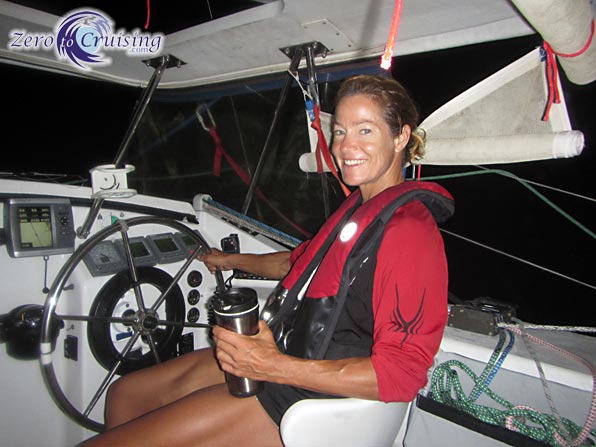
The second day brought much the same as the first. The wind had hardly varied in strength or direction since we’d been underway but the waves had unfortunately built up a bit. I’m not sure if a boat exists that responds well to waves directly on the beam (side) but I can say most definitely that it is not ZTC. We carried on though, maintaining good speed for much of the day, broken up only by lulls which I have to assume were caused by the wind shadow of the islands 30 miles to our east.
We had been fishing ever since we left Bequia but unfortunately, as on recent passages, had been skunked. We had been trying different lures and checking them frequently to make sure that they were not rendered ineffective by weeds. Still we had no luck. We even added new line to our rod and began fishing with two lures out, hoping to double our chances. All that resulted from that was a tangle of lines that would keep Rebecca occupied for hours trying to repair.
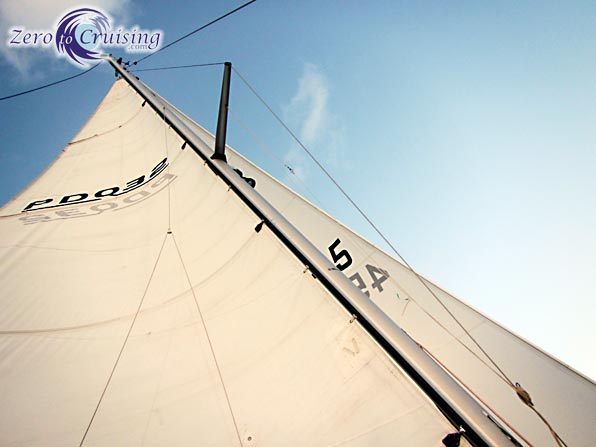


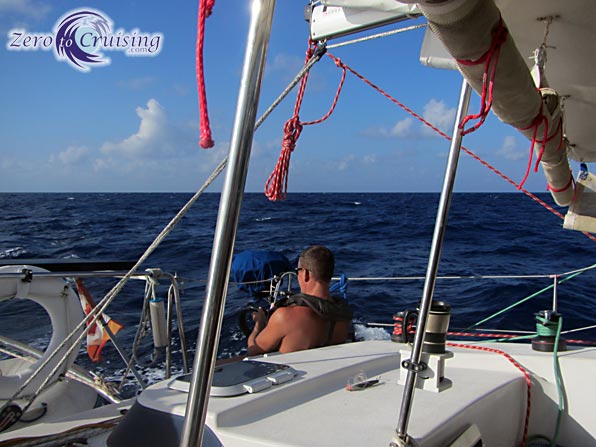


While the sun had continued to shine down upon us in a largely cloud-free sky, that would end just west of Guadeloupe. We were, by this time, some 40 miles offshore and had entered another dead zone requiring us to trade in our headsail for our engines. While it is possible that the lack of wind was created by the island, I was also thinking that it could have been caused by the large squall line that we saw in front of us, it having somehow sucked away all the wind. Regardless of the cause, while we snapped pics of the interesting clouds and rainbows, we prepared ourselves for the showers which were shortly to come. Using the word showers makes these squalls seem much more pleasant than they actually are. Although typically lasting no longer than 10 minutes, tropical squalls frequently include driving rain, high winds and near zero visibility. What would have been serious drama had we been caught unawares with our full headsail up was, now prepared, a minor hiccup in what had thus far been an uneventful passage.


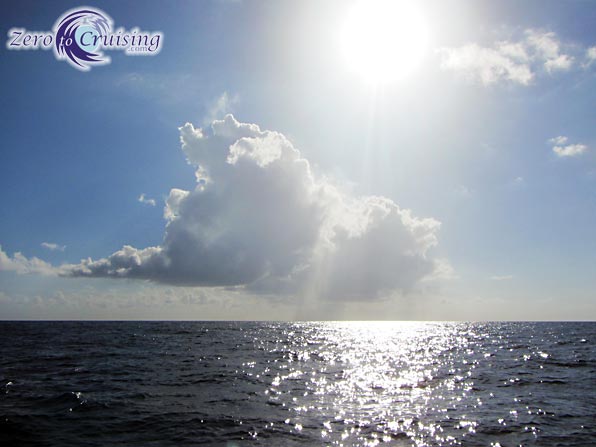


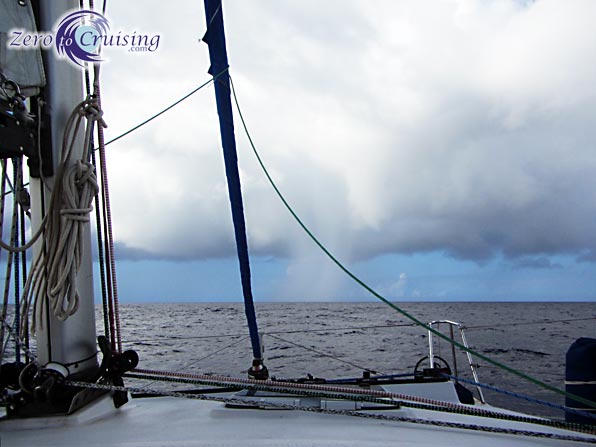


At around 5:00 PM on the second day, just about the time that we would have been considering bringing in our fishing lines (we don’t fish after dark), the line on our handreel tripped, indicating that we might have gotten a strike. I say might because it sometimes trips if we have a big increase in boat speed or if it picks up some weeds. The yoyo had been resting on a winch, the way we always have it but unfortunately, I had our main’s preventer run back and secured to that same winch underneath it. That we do not normally do. The friction caused by the preventer resulted not in the line running freely off the yoyo as it normally does but rather an immediate and irreparable tangle. As I jumped to the winch and surveyed the resulting mess of line, I could also see that we had in fact hooked a fish. It was being dragged by the boat at about 8 knots and now, with the tangle, I had no way to let out any more line nor to easily bring it in. In other words, we had a bit of a problem!
After dumping the traveller and asking Rebecca to fall off onto a deep broad reach to slow us down, I made the decision to don some sailing gloves and try to pull the line in hand over hand. You see, I knew we had those gloves around for a reason. 🙂 Bit by bit, I pulled in the line and when I could, I’d make it fast to the winch. It was already covered in a tangle so I would just wrap the line around it any way I could to secure it, knowing that I’d have a mess to clean up later. As with any line on a boat, I was very careful to not wrap it around my hand or any part of my body. Although I could still not see what we had hooked, I could tell that it was fairly large and I had no desire to see my fingers part from my hand. Rebecca was doing her best to keep us on course but there was little she could do to slow us down any further. The process of me dragging in the line continued for some time but even when I finally got the fish close enough to catch a glimpse of it, I still had no idea what we had hooked. When he broke the water’s surface and flashed his long bill at me, I really started to freak out. I had no idea how I was going to land the fish without getting myself killed in the process but having not caught a fish in so long, I was determined to do it.
Rebecca asserts that if she had had a camera recording a video of the fish-landing drama, she would have an instant classic for our Youtube channel. As I brought the fish close to the stern, on three separate occasions he tried to climb up the transom steps into the boat, chasing me back in the process. I should point out that, during this entire procedure, I was wearing my PFD and was also tethered to the boat.
When we first hooked the fish, I had obtained our landing net and had it sitting nearby. Now, seeing the size of the fish, I knew that it would be totally inadequate. I was going to have to gaff the fish to get it on board. This gaffing process took several attempts and included much yelling. Rebecca was doing her best to not jibe the boat in the rough waves even though her attention kept getting drawn back to the stern, for obvious reasons. After hooking the fish with the gaff 3 times, only to have him shake himself free and drop back into the water, I was finally able to drag the fish into the cockpit on the fourth attempt. It was only then that we realized that we had landed a fish virtually as tall as I am. I won’t go into details about how I rendered the fish incapable of killing us with his spear but I will say that I did it as quickly and as mercifully as I could.
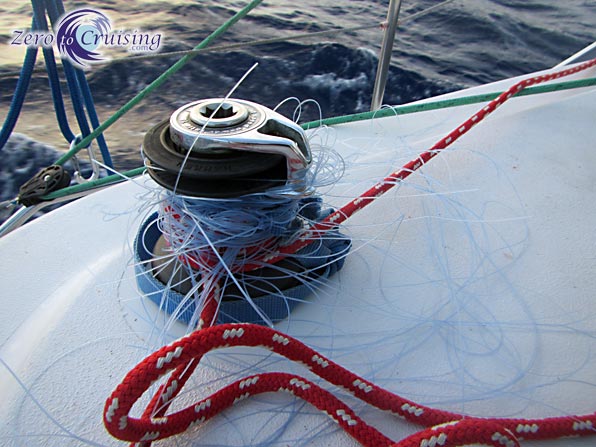

Of course, catching a fish is only part of the story. With daylight waining, we now had a massive fish in the middle of our cockpit that we needed to deal with. With adrenaline levels only just beginning to drop to normal, I took over the helm while Rebecca, ever the trooper, set about cleaning and processing our catch as we continued to bounce across the waves. I would like to make a note here about the role that fishing has for us. We do not fish for sport or for entertainment. Rather, we fish for food. This fish, after cleaning, netted us 32 lbs. of meat, enough to feed us for well over a month, if we ate fish every single day. I was not aware of what type of fish this was when we hooked it, nor really even when we began to bring it on board. After that though, beyond the point of no return, I suspected that I might ultimately hear from some sport fishermen saying that a billfish should be released after hooking it. I will go on record to say that the only time we’re going to release a fish is if it’s too small to feed us, too large to land safely, illegal to keep or we think that it might have ciguatera and poison us.
It was well after dark that the fish story had drawn to a close. The cockpit still looked like a crime scene but without the light of day, we could pretend it wasn’t so. Unfortunately, the squall situation that I described earlier would repeat itself on a couple of other occasions, although even less desirably, at night. Rebecca was alone on watch during one of these times and was wisely able to discern the squall’s approach and wake me with enough time so that we could prepare ourselves and the boat for the deluge which was to come. As before, with the boat properly squared away, the squall was an inconvenience as opposed to a problem which could have resulted in a torn sail, or worse.
By dawn Friday it was obvious that, even if the wind was to die completely and we had to rely upon our engines, we were going to make it to our destination with plenty of daylight to spare. We were both sleep deprived by this point though and were eager to get to St. Martin. There are plenty of anchorages to choose from and in fact, there are even two separate countries to choose from on the island of St. Martin/Saint Maarten, half of it being governed by the French and the other half by the Dutch. While we checked into the Dutch side during our previous visit, this time we opted to initially anchor on the French side in Marigot Bay. As much as the French sailors tend to get the &^%$ taken out of them for anchoring too close and for their men wearing bathing suits which can be a bit on the tiny side, the French have their customs and immigration process organized to the highest level! At a self-serve computer kiosk inside the Port Captain’s office, Rebecca and I completed the checkin procedure in five minutes flat. Total charge? Five Euros, or eight Dollars US. How long of a stay does that pay for? I said 2 months on the form but I don’t think it matters. Did they stamp our passports? No. Did they ask about our cat? No. Did they give us any attitude? Definitely not. The lady who stamped our computer printout and took our money was, by comparison to many customs officials, very pleasant. Viva la France!






Great pictures and story of your passage
Thanks, John. Glad you enjoyed it. Next time you’ll have to join us and stand watch so that we can sleep more.
Lovely post. Lovely pics thanks.
The awkward action of cats to a beam sea is because they have two hulls!
The first hull goes over the wave, just as a mono would, then the second hull goes over the same wave. This gives a double action that is often unpleasant.
Big cats would do better on the lumpy stuff you were getting. However in bigger swells, you would have been more comfortable and a big cat might well suffer. It depends on hull width, wave height and wave separation (wave length). Your 32ft is better than my 26ft for coastal chop, then you catch it further out.
Mike
I would love to try it in a bigger cat some day, or a big mono. 🙂
Outstanding! Enjoy St. Martin.
Thanks, Kirk. We hope to.
Excellent post Mike. One of your best. Great detail, but I am surprised you called it an uneventful passage. What kind of fish was that, a swordfish?
Why uneventful? I guess our tolerance for dram is pretty high. It’s not like we had to get towed in or anything. 😉
As for the fish, according to the comments here, it is a shortbill spearfish.
Prayed for you guys the whole way! This is a “GREAT” post. Thanks for taking the time to take those beautifull pictures and document the trip. Looking forward to seeing your account of St. Martin. Thanks again, JC
Thanks, JC. I’m glad we had something interesting to write about, but not TOO interesting. 🙂
The fish you have caught is a Shortbill Spearfish.
It is neither a sailfish nor a marlin, more like a mix of the two. Nice catch. They are fairly uncommon, but that is not because it is over-exploited; it is simply so.
Thanks, Etienne! We really weren’t sure exactly what it was. My guess was sailfish but the “sail” wasn’t quite as big as in the pics I had seen.
Great fish Mike, the picture of the winch adds new meaning to the word clusterfuck!
A pic is worth a 1000 words, blah blah blah.
Great story! How was the fish?
Quite tasty actually. I can smell some more cooking right now!
Excellent post and pictures. Thanks for sharing the story. Awesome you caught the fish too, sounds like a lot of protein in the…er…how do you guys store that much fish…I didn’t think the typical PDQ had much refrigeration space? Anyway, glad you made it safe and sound and even got some groceries in the process.
Fortunately our freezer was pretty much empty. It completely filled the freezer and there was still 3 large zip lock bags of meat that we had to store in the bottom of the fridge. Guess what’s for dinner? 😉
Knew you had to get a fish this passage! Havent seen a story in a while and with lines out for 2 days straight(except for nights) your bound to get something.
Glad we didn’t let you down! 🙂
Wow, what an adventure !! Glad to read you made it safe and sound !! Wishing you safe (and fun) travels home.
Thanks, guys. I could use a bit less adventure on the next passage.
WOW – great adventure, with a bonus score !! Safe travels on your voyage “home” to loved ones.
Great passage and post! I was watching your SPOT and noticed a few speed bursts along the way.
🙂
Fast… slow… Fast… FASTER… slow…
What an excellent post. You really do take all of us readers along for the ride, and with those spectacular photos (the clouds!), and the excellent description of your passage and fishing adventure, I feel inspired, and thrilled for you both. If someone told you guys – before you bought the boat – when you were just starting the hatch this plan, that you’d wrestle a shortbill spearfish as long as you – hand over hand – in tropical waters, during a muti-day passage, while Rebecca was at the helm – skirting squalls – I wonder if your imagination of it would have come close to the sharpness of the real thing. What a blast. I’m so glad you document all of this. 🙂
Do the engine repair posts inspire you equally? 😉
Hey Mike! I just spotted this post over on weather.com (http://www.weather.com/news/von-karman-vortices-20130131) and it reminded me of this post of yours and the problems that the lee side of an island can cause. Thought you might get a kick out of the photo!
Wow, that’s pretty cool. Thanks.
Awesome Post! I LOVE to hear about things like the fish fight lol, great job guys, keep it up!
Thanks, Ed! For the future, we’d prefer to catch slightly smaller fish.